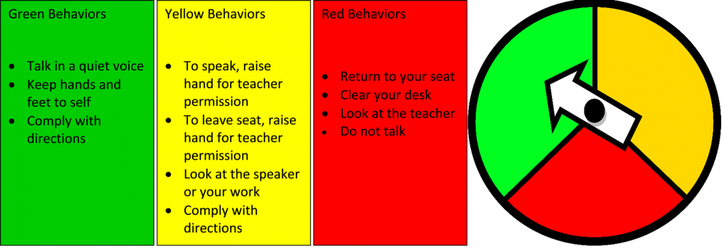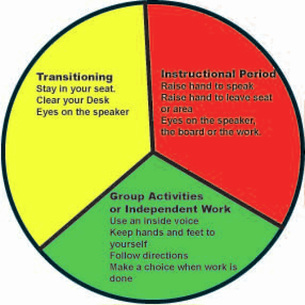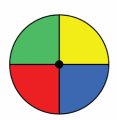What is the Color Wheel?
The Color Wheel is a behavior management intervention strategy that can be used for a whole class, small group, or an individual student. According to Intervention Central, "the Color Wheel is one solution that enforces uniform group expectations for conduct while also responding flexibly to the differing behavioral demands of diverse learning activities". In a typical Color Wheel, there are three sections identified by color. Usually these colors are green, yellow, and red; but these can be adapted to meet the needs of any student. In the green section are behaviors that are expected during free-time activities or low-structure activities. Some behaviors in the green section might include keeping hands to self, and talking in a quiet voice. In the yellow section these are expectations during whole-group or small-group time. Yellow behaviors might include raising hands before talking, and look at the speaker. The red section are expectations that are used during transition times, or from switching to new activities. Red behaviors might include walking feet to the carpet, or no talking. As student expectations switch between colors, the teacher can either point to the color on the wheel or use an arrow to help remind students.The color wheel should be displayed where all students can see it. If a teacher has just one student who needs a color wheel because they have a difficult time following directions and knowing their expectations, the color wheel might be really beneficial for them. The student's color wheel can just be placed at the corner of their desk and the teacher can go over and move it in the correct section. This will help that student because he or she will have a constant reminder of their expectation. For students that have a very difficult time with transitions, the teacher should give a 30 second warning when the student's expectations are changing-- this might prevent any potential meltdowns. When using the color wheel as a behavior management strategy, the teacher should keep time in the red zones to a minimum and the red zone should not be used as a punishment. Intervention Central said, "Linking the red condition with punishment raises the possibility that students will fail to comply with the red behavioral rules because they are seen as punitive rather than necessary to support an effective learning environment".
How to use the color wheel intervention:
The Color Wheel is a behavior management intervention strategy that can be used for a whole class, small group, or an individual student. According to Intervention Central, "the Color Wheel is one solution that enforces uniform group expectations for conduct while also responding flexibly to the differing behavioral demands of diverse learning activities". In a typical Color Wheel, there are three sections identified by color. Usually these colors are green, yellow, and red; but these can be adapted to meet the needs of any student. In the green section are behaviors that are expected during free-time activities or low-structure activities. Some behaviors in the green section might include keeping hands to self, and talking in a quiet voice. In the yellow section these are expectations during whole-group or small-group time. Yellow behaviors might include raising hands before talking, and look at the speaker. The red section are expectations that are used during transition times, or from switching to new activities. Red behaviors might include walking feet to the carpet, or no talking. As student expectations switch between colors, the teacher can either point to the color on the wheel or use an arrow to help remind students.The color wheel should be displayed where all students can see it. If a teacher has just one student who needs a color wheel because they have a difficult time following directions and knowing their expectations, the color wheel might be really beneficial for them. The student's color wheel can just be placed at the corner of their desk and the teacher can go over and move it in the correct section. This will help that student because he or she will have a constant reminder of their expectation. For students that have a very difficult time with transitions, the teacher should give a 30 second warning when the student's expectations are changing-- this might prevent any potential meltdowns. When using the color wheel as a behavior management strategy, the teacher should keep time in the red zones to a minimum and the red zone should not be used as a punishment. Intervention Central said, "Linking the red condition with punishment raises the possibility that students will fail to comply with the red behavioral rules because they are seen as punitive rather than necessary to support an effective learning environment".
How to use the color wheel intervention:
- Define behaviors for each color
- Create the posters and hand them up
- Teach student(s) how to use the color wheel
- Begin intervention
Student Profile
In my kindergarten classroom, I have a student who has a very difficult time transitioning between new activities. Once the new activity has been going on for about five to ten minutes, the student is engaged and learning. However it is the five to ten minutes leading up to when he is engaged when he is unable follow directions or settle back down. A color wheel will help him tremendously, because he will be able to see what his expectations are clearly. He could even have a copy taped to his desk for even a more visible reminder. I could just walk over to his desk and tap the section that we are in, for example. As his teacher, I will move the color wheel and let the entire class know that I am changing the wheel, about one minute before a new activity begins. This will give my student proper notice of what is going to change, and what the students new expectations are. Since he is a kindergartner and unable to read completely, picture and graphics of expectations would also be really beneficial.
In my kindergarten classroom, I have a student who has a very difficult time transitioning between new activities. Once the new activity has been going on for about five to ten minutes, the student is engaged and learning. However it is the five to ten minutes leading up to when he is engaged when he is unable follow directions or settle back down. A color wheel will help him tremendously, because he will be able to see what his expectations are clearly. He could even have a copy taped to his desk for even a more visible reminder. I could just walk over to his desk and tap the section that we are in, for example. As his teacher, I will move the color wheel and let the entire class know that I am changing the wheel, about one minute before a new activity begins. This will give my student proper notice of what is going to change, and what the students new expectations are. Since he is a kindergartner and unable to read completely, picture and graphics of expectations would also be really beneficial.
Visual Representations
Here is an example of what the color wheel might look like with some example behaviors. Green behaviors are low-structure activities, yellow behaviors are large group/small group activities, and red behaviors are transitions. The wheel is made into a spinner where the teacher can move the arrow to the section on behaviors the students should be doing.
|
Here is another color wheel with similar student expectations. However, the colors are changed. Red indications instructional time, yellow is transitioning, and green is group or independent work. Students will be able to clearly see what their expectations are. For younger students that are unable to read, it might be helpful to use pictures to place in the sections.
|
Content Area Examples
The color wheel is not specific to just one content area, therefore it can be used in all subject areas. Generally with a color wheel, student expectations are consistent throughout all content areas. The only areas where the Color Wheel might change would be for specialist classes such as music, art, and physical education. However it is up to the discretion of the teacher of when to change expectations for each color. Here are some examples for specialist classes:
Physical Education-
Yellow (instructional time)- eyes on the teacher, equipment still, and quiet feet
Green (free time)- inside voices, hands to yourself, and share with others
Red (transition)- line up, get a drink, no talking
Music-
Yellow (instructional time)- eyes on the teacher, instruments still, and sing when asked to
Green (free time)- inside voices, hands to yourself, and share with others
Red (transition)- line up, no talking, and clean up
Art-
Yellow (instructional time)- eyes on the teacher, materials ready, voices quiet
Green (free time)- inside voices, hands to yourself, and share with others
Red (transition)- line up, clean up materials, no talking
The color wheel is not specific to just one content area, therefore it can be used in all subject areas. Generally with a color wheel, student expectations are consistent throughout all content areas. The only areas where the Color Wheel might change would be for specialist classes such as music, art, and physical education. However it is up to the discretion of the teacher of when to change expectations for each color. Here are some examples for specialist classes:
Physical Education-
Yellow (instructional time)- eyes on the teacher, equipment still, and quiet feet
Green (free time)- inside voices, hands to yourself, and share with others
Red (transition)- line up, get a drink, no talking
Music-
Yellow (instructional time)- eyes on the teacher, instruments still, and sing when asked to
Green (free time)- inside voices, hands to yourself, and share with others
Red (transition)- line up, no talking, and clean up
Art-
Yellow (instructional time)- eyes on the teacher, materials ready, voices quiet
Green (free time)- inside voices, hands to yourself, and share with others
Red (transition)- line up, clean up materials, no talking



